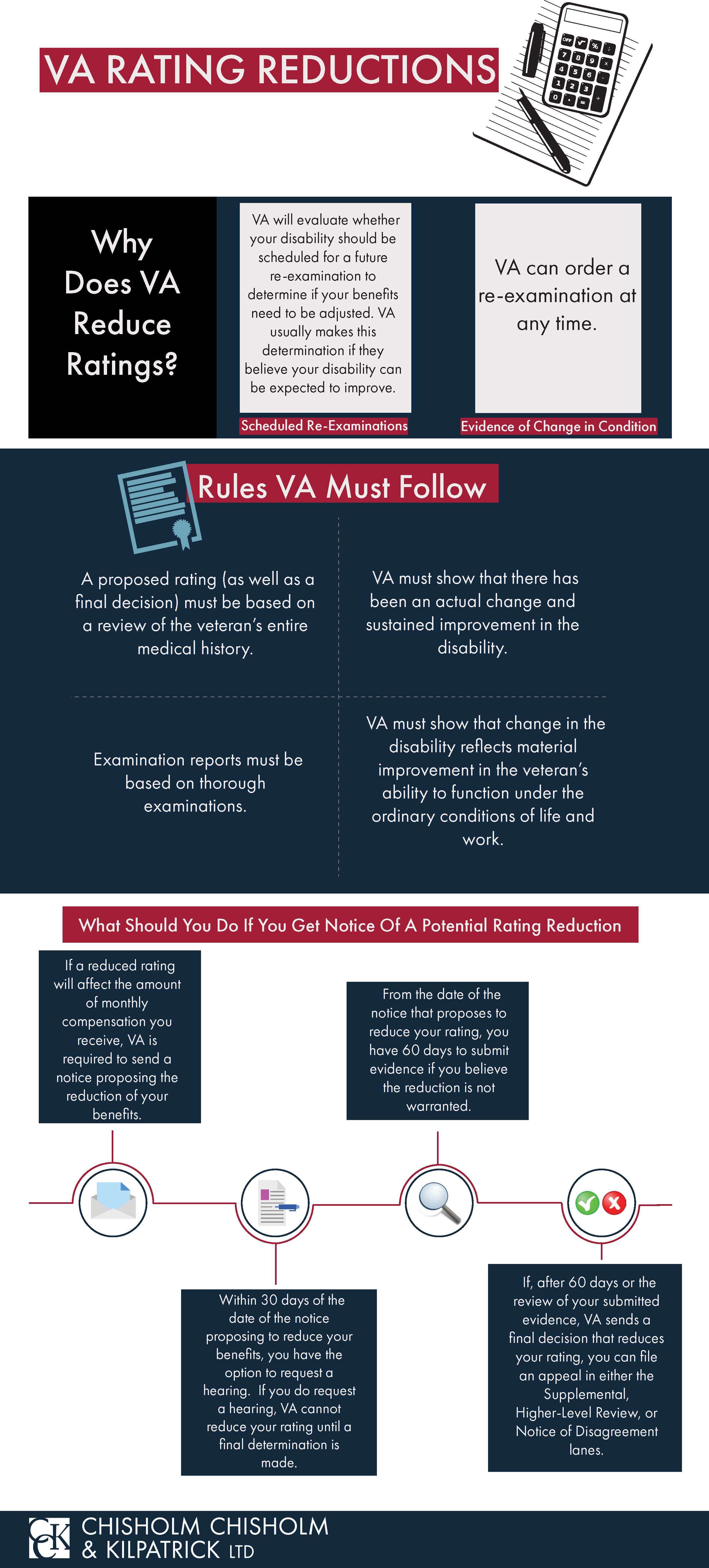Is My VA Disability Rating Permanent?

CCK Law: Our Vital Role in Veterans Law
VA offers protections for disability ratings that have been in effect for certain periods of time. Furthermore, there are a few occasions in which your VA disability rating may become permanent. Until these regulatory protections kick in or your ratings become permanent, VA may sever or reduce a veteran’s disability rating based on specific findings. To determine whether your service-connected condition still warrants a particular disability rating, the U.S. Department of Veterans Affairs (VA) will require you to undergo an examination.
When Can VA Reduce Disability Ratings?
Veterans with service-connected conditions that are not considered permanent may be sent for future Compensation & Pension (C&P) examinations in order for VA to evaluate the severity of those conditions and rate them appropriately. If VA finds that a veteran’s condition has improved, it can reduce their disability rating. According to 38 CFR § 3.105(e), a rating reduction may only take place in cases where:
- VA has reviewed the veteran’s entire medical history
- The veteran undergoes a thorough examination that is adequate for rating purposes
- VA finds sustained improvement in the veteran’s ability to function under the ordinary conditions of life, including employment
Here, “sustained improvement” is considered to have been demonstrated when a preponderance of evidence portrays a lessening of service-connected symptoms that has persisted consistently over time, across situations, and under the conditions of ordinary life (38 CFR 3.344). In other words, the improvement must not be circumstantial in nature or attributable to mitigating factors, such as:
- A disability’s predisposition to temporary or episodic improvement
- Temporary alleviation by prolonged rest, or
- Less thorough or complete modes of examination
When reducing ratings, VA is also required to issue notice of the proposed reduction and give the veteran 60 days to submit evidence and 30 days to request a hearing. However, if the reduction would not change the actual amount of compensation that a veteran is receiving, VA does not have to issue notice of the reduction.

When Your VA Disability Rating Might Be Permanent
VA deems a disability “permanent” when it is reasonably certain, based on medical evidence that the level of impairment will continue for the rest of the veteran’s life. For this reason, VA is allowed to take age into account when determining whether a disability is permanent and it can be more difficult for younger veterans to be considered permanently disabled. When VA decides a veteran’s service connected condition is permanent in nature, it no longer requires veterans to attend re-examinations. According to 38 CFR § 3.327, you are exempt from future examinations when:
- Your condition is static (unchanging);
- Your condition has “persisted without material improvement for a period of five years or more” (i.e., stabilized rating);
- The “disability from disease is permanent in character and of such nature that there is no likelihood of improvement;”
- You are over 55 years of age, although some exceptions may apply;
- The rating you received is the prescribed minimum rating; or
- If a lower rating would not affect your combined disability rating
How to Know When Your Disability Rating is Permanent
Take a look at the decision letter VA sent you when granting benefits (i.e., your Rating Decision’s Notice of Action letter). On some Rating Decisions, there is a Permanent and Total box that will be checked if your 100% disability is permanent. On others, there may be language like “eligibility to Dependents Chapter 35 DEA / CHAMPVA are established” or “no future examinations are scheduled” – both of which can indicate permanence. The exact language may vary with different VA Regional Offices.
If the letter says that future examinations are scheduled, then your disability rating is not considered permanent by VA.
Asking VA to Make Your Disability Rating Permanent
If you believe (and you have evidence showing) that your disability is unlikely to improve at any point in the future, you can submit a claim to VA requesting a permanent rating. With your claim, you should include medical evidence, treatment records, and doctor’s opinions showing that your condition cannot be expected to improve in the future.

Protected VA Disability Ratings
Congress has determined that under certain conditions it is not necessary for VA to expend resources to check on a veteran’s service-connected condition. As a result, some disability ratings can become “protected.” A protected disability rating is a VA disability rating that cannot be reduced or revoked by VA in the future. This is known as a “protected rating.” There are several types of protected ratings, including the following:
Stabilized Ratings: 5 Years or More
Any rating that has remained at the same level for five years or longer is considered “stabilized.” In addition to the general rating reduction rules that VA must follow (see above), VA must also show sustained improvement in your condition. This means two things: (1) VA cannot use just one re-examination to show “sustained” improvement. Rather it must show through medical records as well as a C&P re-examination that you are not just temporarily experiencing improvement; or (2) VA must show that evidence in your claims file predominantly demonstrates “sustained” improvement. In either case, VA must provide an explanation of why they are reasonably certain that your condition will continue to show sustained improvement.
100% Total Ratings
VA can reduce a total rating (i.e., 100% disability rating) only if there is material improvement in the veteran’s condition. In addition to the general rating reduction rules, VA must provide evidence that the veteran’s condition has improved such that there has been an observable change in their ability to function under the conditions of daily life.
VA Ratings at 10 Years
VA cannot sever service connection for Veterans who have been rated for that condition for 10 years or more. VA can reduce a Veteran’s rating, but not terminate benefits unless there is evidence of fraud.
Continuous Ratings: 20 Years or More
Service-connected conditions that have been rated at or above a certain disability rating level for 20 years or longer are considered “continuous.” VA cannot reduce a continuous rating below the original level (unless they determine the rating was based on fraud). For example, if a veteran’s service-connected depression was originally rated at 50% disabling and fluctuated between 50% and 70% over the next 20 years (without dipping below 50%), VA could not reduce the rating below 50%.
Permanent and Total Disability
If VA rates you as permanently and totally disabled, your disability rating should not be reduced. Permanent and Total Disability means your service-connected condition is 100 percent disabling with no chance of improving. As a result, VA will not schedule you for any further C&P examinations.
TDIU Ratings Are Not Always Permanent
It is important to note that the Total Disability Based on Individual Unemployability (TDIU) is not always permanent. For veterans that have been granted entitlement to TDIU, VA can only revoke TDIU status if “actual employability is established by clear and convincing evidence” (38 CFR § 3.343(c)). In other words, VA can only sever your TDIU status if you have been found to be capable of substantially gainful employment. It is important to note that in order for the employment to be substantially gainful, the veteran would have had to be employed for at least 12 consecutive months and earning over the federal poverty threshold.
Note: VA can revoke your disability benefits if it determines that you obtained the rating through fraud or determined it made a “clear and unmistakable error.”
Our Team May Be Able to Help Fight Proposed Rating Reductions
If VA is attempting to lower your disability rating, the veterans’ advocates at Chisholm Chisholm & Kilpatrick LTD may be able to help.
Call 800-544-9144 for a free case evaluation with a member of the CCK team.
Share this Post
